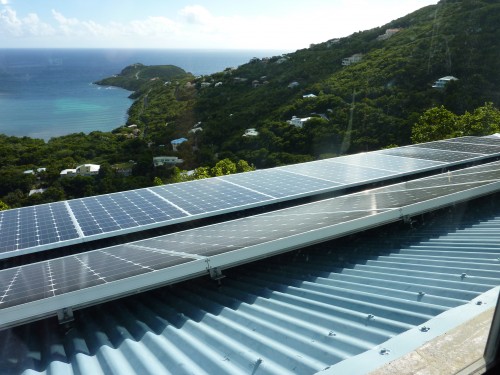
For years I have wanted to do my own solar project. Last summer, I finally decided to take the plunge and do an off-grid solar project. Over the years I’ve done a lot of research, talking to contractors, and neighbors who have done this, but there were only two other off grid solar projects in the area that I knew of. Both were actually small solar power “mini-grids” as their homes were more like compounds and so much larger than mine. They were using their batteries more for backup than their primary source, So we were entering new territory for myself as well as my installer.
The Basics – Data Collection
The first thing I needed to do was determine my average power consumption. I purchased a wireless power monitor, which clamps around each 120V leg of my 240V grid power service. This device transmits data to a receiver that records daily averages and the data can be output to a spread sheet through USB connection to a laptop. I placed the monitor in a central location so I could watch the results on a real time basis. It was interesting to see what various household devices were drawing. An overhead fan draws 100W. The water pump kicks in, 1000W (1Kw), same with an A/C unit. etc,. After 2 weeks I determined that my average daily needs were about 15 – 20 Kw, total. (I rarely use A/C but more on that later). I then replaced all lighting with LED lights. These were mostly 60 Watt bulbs that draw 8 Watts. We then isolated the wiring for the bedroom A/C units, and Washer Dryer, to a separate power panel that connects to the grid, so I do get a very small power bill if I occasionally decide to use A/C. A 50 gallon water heater (1400 Watt power hog), is at this time still on the solar system, and timed to heat water twice a day for 30 minutes. This provides plenty of hot water for 2 people.
The Hardware
We decided to size the system to produce 5800 (5.8KW) per hour. I wanted to add some room for growth so we went with a Schneider Electric 6880 Hybrid Inverter. The hybrid inverter accepts input DC Voltage from PV Cells, Batteries, Wind Power, Hydro, or DC Generator power and converts that to 240 VAC true sine-wave household power.
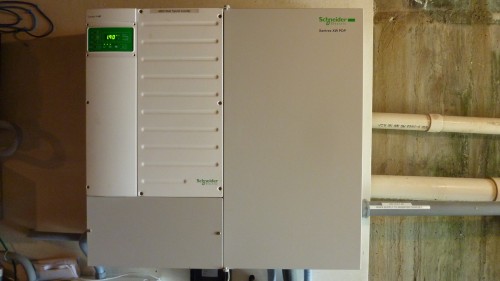
The Inverter is connected to a transfer switch that can transition house voltage from grid to solar. We then decided to use (22) 265 Watt solar panels (22 panels times 265 Watts to equal 5830 Watts), mounted to the roof. The solar panels are rated for sustained wind speeds up to 175 MPH.
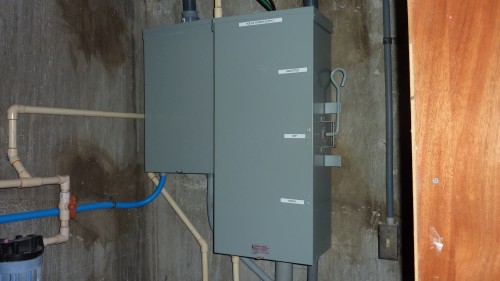
For storage we went big, using (12) 424 pound, 8 Volt Rolls Surrette 5000 series wet cell deep cycle batteries. Each battery is actually composed of four easily replaceable 2 volt batteries connected in series. These are configured in (2) banks of 6 batteries, or two 48V DC strings in parallel fed to the inverter. We chose these batteries for their solid reputation, and 15 – 20 years life expectancy. I am highly skeptical of that claim, and felt if I had any hope of achieving a life expectancy like that, the batteries need to be carefully maintained. For that we chose (3) Midnight Solar Classic charge controllers.
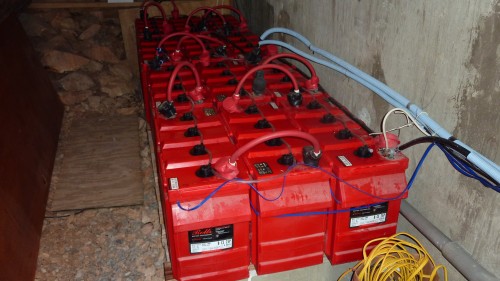
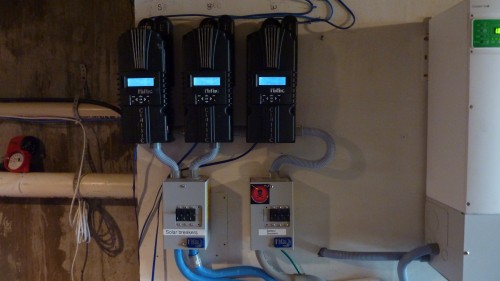
Simply put, the charge controllers’ job is to keep the batteries happy. They monitor and protect the batteries from overcharging as well as deep discharge depending on the parameter settings of the batteries. They are tied into my LAN so I can monitor the batteries and make parameter changes from my desktop computer, or remotely over the internet if necessary.
The batteries require water every couple of months, so we installed a 5 gallon, gravity fed self watering system. The cells are connected by a system of tubing, and all I have to do is attach the reservoir to each bank and they are topped off in minutes. Otherwise I would have to fill each cell individually.
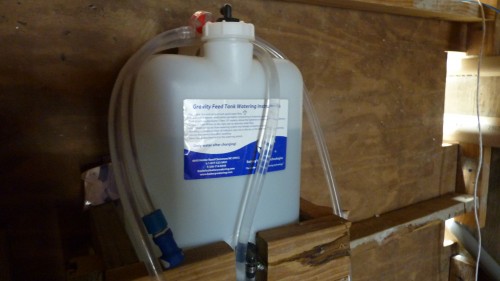
The Results
Where I live I can expect over 320 sunny days per year. With an average of 6 hours of usable sunlight per day, the panels produce 5 – 6Kw per hour for a total of 30-35 Kw per day. The house runs almost totally off the batteries, and the system generates enough to power the house and keep the batteries topped off until sundown. The transfer switch in my equipment room allows me to switch from solar and back to the grid if any of these systems fail. I began to become a little concerned when we went through a two week cloudy period, relatively rare for this area. It’s easy enough to switch over to grid power but being a lazy techie, and not wanting to get up in the middle of the night, we came up with a different solution. We installed an automatic switch (solenoid), that we hooked up to the generator input side of the inverter, kind of tricking the inverter into thinking we had a generator hooked up. (A feature I think that should be included in future builds of the inverter). This solenoid is triggered when the batteries voltage drops to 48.6V, and supplemental grid power goes straight to charging the batteries. It then opens when the batteries again reach 57V, thus I never really have to worry that my batteries are being discharged too much, damaging them and shortening their (expensive) life.
The Fake Generator (Solenoid)
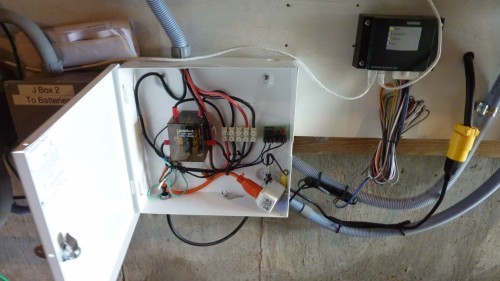
Monitoring and Software
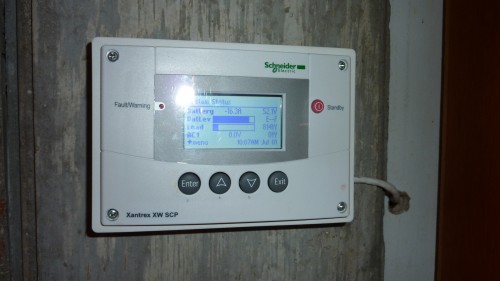

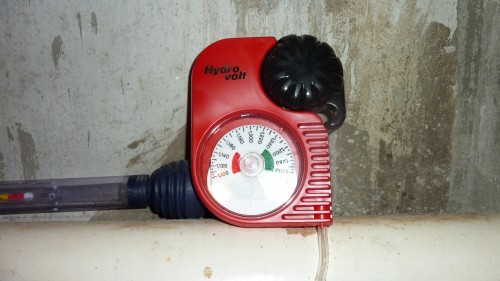
Conclusion
Hybrid off grid solar is definitely not for the novice. Once installed, it required weeks of tweaking to get to a point where the batteries were being charged properly. The use of a good hydrometer to measure specific gravity, (the only true measure of a batteries’ charge), and proper monitoring (the Charge Controller application software comes in very handy) and adjustments were necessary to attain the results I was looking for. One of the charge controllers failed at one point and needed to be replaced. Firmware upgrades, resetting to factory settings then reprogramming were applied to remove bugs. Standard laptop to device uploading of firmware familiar to techs, but not to the average homeowner was necessary. The Schneider 6800 inverter has performed flawlessly, requiring no intervention. Considering the costs savings for me in this area, the trouble and expense was worth it. But, if my electrical costs were .08 cents per KWh, then it would probably not be a good investment.
One of my reasons for going off-grid as opposed to the Net Metering option was that the local power utility limited the number of Net Metered Solar projects, and was not taking any more applications. That has since changed and there are also provisions for Net Metering with Hybrid systems using battery, wind or generators. So with any luck, and given the fact that I am able to create twice as much power as I am using, I may be able to sell my excess power back to the grid, and offset what little I use. And maybe, (probably not), get a little bitty check at the end of the year. I understand they are supposed to be paying back 17 cents per KWh, but I know of no one who has actually been paid for their power. I won’t hold my breath.















Or:
https://youtube.com/watch?v=4i3-w6MZP1U
Hey!–that looks like a real “system.”
congrats.
I’d be interested in the payback/break even/life expectancy calculations. It “sounds like” you didn’t and wont be using solar direct hot water heating? Seems like a natural to me…even with the Solar you have to lighten the load?
I opted out of a roof based water heater for now, since I am creating twice the power I need, and it was another large expense. But two timed runs of 30 minutes per day works well.
For years I just used a black hose coiled on my roof as a pre-heater for my hot water tank. Then I managed my use of hot water to coincide with that pre heat…used hot water in short bursts.
Didn’t have a large storage tank and didn’t have any monitoring equipment to tell if the effort saved anything. Then I moved, and things went back to normal.
Black hose can really get water hot though.
Electricity Storage Systems is the block to Green Energy right now. For fun…..I’d look at alternatives to batteries….. like compressed air. “Nice” as it does store your energy and can run a car or even air conditioning. Not off the shelf as yet…. will be if the Tata gets sold here.
Pros and Cons to all we do. BATTERIES (lead / acid). Kinda a dinosaur tech weighing down the future?
Storage is THE problem. But I didn’t like the idea of going dark when the local utility goes down, as it often does. If your using grid-tied solar, then you go down with them. And a noisy generator that requires feeding wasn’t a pleasant option either.
Years (eg 10-15?) ago Popular Mechanix or Science or whatever had an article about a SF guy that used solar panels to make hydrogen gas. He stored that in a few converted propane tanks. He then could burn the hydrogen directly or run it through a generator. Lots of conversion wasted energy but the source is free. The safety issues were supposedly taken care of with the storage medium inside the propane tanks.
Again, as you know so well, anything to avoid the battery. But hydrogen gas/liquid/conversion/storage still scares me a bit…… driving me back to compressed air as a storage/use medium.
The only other I can think of is flywheel storage….but that has never made sense to me and a heavy weight spinning at 50K revolutions is scary too.
But so are batteries.
Pros and cons.
There has been significant efficiency improvement with different types of Catalyzed Hydrolysis. I don’t what has been commercialized yet.
Couple a vastly improved Hydrolysis process with good storage and the new much more efficient and cheaper fuel cells and you have an awesome future proof energy system!
Many car companies are betting serious money in Hydrogen Fuel Cell technology as an economical viable future of transportation and it is not just Toyota that will sell you a Hydrogen-Powered Car very soon if not now!!!
I don’t see hydrogen storage any more dangerous then natural gas, propane or gasoline. However, it is strongly recommend you don’t paint your hydrogen storage with cellulose acetate butyrate with aluminum powder added (remember the Hindenburg)!!
Ain’t technology grand?
Our future is so bright, I wish the dark cloud of AGW wasn’t going to do its job about 100 years too soon?
So close!
Leaving open, what DRASTIC responses might give Green a chance to replace coal before our civilization crumbles.
Yes……………so close.
Why should America GO GREEN when it won’t make any difference unless China and India do too?=======>To lead by example.
The dream is to have a clean, green, ample and cheap means of electric energy generation. With this abundant cheap electric energy, we can enable abundant cheap supplies of hydrogen to combine with captured/trapped carbon from the atmosphere (current emissions > 550m tones), to create and satisfy most if not all our hydrocarbon needs, in a carbon neutral way.
I say dream in a much advised way; but, if you don’t aim for a target, you can never hit it!
There has been a lot of hype around thorium molten salt reactors (LFTRs) saying it can be a clean, safe, green, ample and cheap means of electric energy generation. LFTRs are potentially safe because they don’t use water cooling (operate at low pressure and high temperatures, unlike today’s LWRs) and shut down automatically after an incident/accident.
Apparently the Chinese taking this seriously and are using and building on our Oak Ridge national laboratories research that was abandoned due to politics in the 70s.
The UK government’s Department of Energy and Climate Change (DECC) looks at the potential of thorium and says that while thorium remains on its radar screen as a topic of interest, its benefits are often overstated. So take all this with a grain of salt, molten salt that is.
Some of the benefits of LFTRs are:
• LFTRs can use waste heat for desalinating water.
• Because LFTRs run at higher temperatures, thermodynamics enable more of the reactor heat to be converted to electricity (50% in LFTR vs 35% in LWR)
• LFTR(s) are 100-300 times more fuel efficient than LWRs.
• Significant amounts of thorium are present in current mine tailings, which would economically incentivize its removal from the environment. This would a huge economic benefit to our mining industry, in particular our rare earth mining along with coal, tin, phosphate and …
NN–gee, you are a bit ‘into” this?
Beyond the mere technology of all the not proven Big Tech==I have a major concern for any tech beyond what McCullough is doing by going OFF GRID, which is a variety of being independent of the powers that be: distributed power production where the entire society/town/neighborhood does not “go down” because of some central production unit.
No monthly bill by some large energy conglomerate overcharing…. no target for terrorits and so forth.
Its a real “social” concern unrelated to the tech. The Already TOO RICH don’t support such system because===they can’t bet even richer.
But I am for PEOPLE POWER…… as an expression of FREEEEEEEEEEDOM.
So…thorium/schmorian. All such tax breaks and grants and fundings should be stopped in favor of giving same to off the grid, decentralized, individual, home owner programs.
Its the wave of the future.
Like you I am all for “PEOPLE POWER…… as an expression of FREEEEEEEEEEDOM.” and not the tasty “soylent green” kind.
However, as a practical matter, I wonder “HOW BIG” of a “return on investment” McCullough will realize after he recuperates the large upfront investment in Panels, Inverter, Installation and ongoing maintenance…
Yes systems cost are going down and I hope they continue. Expensive R&D is helping to increase single junction solar Panel efficiencies, albeit at a trickling rate. SunPower model “X21-345” is claiming very respectable 21.5% efficiencies. 44.7% efficiencies are possible with multiples of 2X the panel costs (III-V multi-junction solar cells for space applications)
I would like to know but suspect the ROI (I could be wrong) may total a couple thousand over the typical 20yrs panel life span?
Bobbo, what did you do?
Is it something like this?
http://www.drroyspencer.com/2010/04/the-spencers-swimming-pool-goes-solar/
NFS—spooky.
I think that is the very picture that first got me going on my diy solar. I had the entire south roof covered in hose, actually irrigation drip line, two 500 foot rolls.
“Since we are on the subject”–I will repeat a prior musing: If I could, just for fun, I would install such a system all around the decking of a swimming pool. This would keep the concrete cool while heating the pool. A low power water pump on a daily timer. Cheap, reliable, easy.
I’ve never built “new” so I never bothered with the calculations, but I would want to size the pool to the energy storage system needed to have a water to air heat exchanger. Those are very efficient to heat in the winter and cool in the summer given enough water in the pool.
Interestingly, run the system in reverse in the hot summer at night and use the system to cool the house.. I wanted to calculate how hot the pool would get and so forth. Run that at night as well to cool off the pool during the night so it could absorb house heat in the day time.
THE KEY: the efficiency of water to air heat exchange.
Like all my fun ideas—I never got farther than 1000 feet of drip line……..but if I were ever to build a pool…………………
Yes….I was going to put in in the attic space for the cooling, but feared for leaks.
Pros and Cons. I like your “high tech” analysis but you left out my main considerations: cost and ease.
Once you start putting things under glass, you are investing some money and some structure. Thats a good thing….if you have the time. working 12 hours a day did not leave me much time for hobbies.
I also really get off on “going to basics” and seeing how cheap something can be done with off the shelf (adapted usage is even better WHILE NIRVANA is achieved with multiple usage–like heat exchangers working both ways).
I DO also like polishing a turd to high brilliance. That takes more study, monitoring equipment…and usually some tech help.
Pros and Cons. None of it wasted when going independent and green.
So I’m the one that told you about it to begin with. Too much resistance in the hose so the pump is operating way below capacity.
I think you made a mistake when you calculate your average daily usage. You need your peak daily usage, or at least mostly peak usage, and make sure your batteries have at least that much output. If for one hour you are using lots of things simultaneously, and the other 23 hours are quiet time, your average usage is not a good metric.
My average daily usage is 18 Kw, if your talking about peak usage, its rarely more than 2.8 KW and generally around 1.2.
Yes, that was what I meant. So a Tesla powerwall would leave you short on power at peak usage as it only goes to 2kW. It appears your batteries are capable of 5.8kW?
I haven’t looked into the power wall thing, but I will.
Seems sketchy?
OK, what I saw on the Tesla Battery was a 7Kwh or 10 Kwhr option. So I can use 1000 watts per hour for 7 hours before it dies. Not bad for $3500.00.
BUT, that would deplete the battery, and that’s not good for the battery.
On the other hand…at my usage, about 200 watts per hour while sleeping, it would seem like a great deal.
The 7kwh is supposed to be more of a protection against outages, the constant full depletion is not desired.
However, you would be limited to 2kw max output.
http://energy.gov/eere/energybasics/articles/concentrating-solar-power-dishengine-system-basics
I like the sterling Dish systems…and they can work in more areas then solar..AND make your hot water, also..
AND if you really need it, use it in floor heating units..in winter..
Elon would be proud.
On a more serious note, I LOVE these updates. This is excellent!
No he wouldn’t. There’s no money in it for him.
If McCullough announced that this is the future, and it saves him lots of money within a week, then Elon would be proud.
Cost for system?
It was in there, and somehow I must have edited it out. The cost after 30% tax rebate was 30K.
At the local rate of 47 – 53 cents per Kwh, its a five year break even. The batteries really drove up the cost.
Wow that is some expensive power.
My understanding is that the cost of solar installation has dropped 50% since 2010.
The question is, if the cost drops 10-30% in the next few years, would it have been cheaper to live off the grid til your landed cost was at say 15K?
[Graph of the Day: The plunging cost of renewables](http://reneweconomy.com.au/2015/graph-day-plunging-cost-renewables-49704)
[Solar Costs Will Fall Another 40% In 2 Years. Here’s Why.](http://cleantechnica.com/2015/01/29/solar-costs-will-fall-40-next-2-years-heres/)
No. Do the math.
I’d be interested in costs too, although it would be much greater here, I’m sure.
Also, remember there is a difference between kW (kilowatts) and kWHr (kilowatt-hours). The first is a rate or flow of energy, and the second is a quantity (‘unit’).
Have you yet decided if you would like to have done/tried something different? … or … have you identified how to make the system better?
Did you have any issues in finding DC products? How many different dc circuits/equipment do you run in the house? Do the various DC pieces run off an AC to DC converter or from a DC to DC transformer???
Lots of issues. “Fun” just to do. Saving money and the planet, almost a second tier issue.
I use standard AC products throughout the house. Other than electronics that use DC. Propane stove, grill. I have considered switching to a propane clothes dryer, which will run off a 20LB. tank for a year, for two people. We live pretty simply.
I’m also considering a diesel generator, as backup. Seems like overkill at this point.
Right now, I am using 5 ceiling fans (500 W), TV and Amplifier, Several computers, 2 refrigerators, maybe a light or two in my office. At the moment, my load is 845 Watts. At night that drops to about 200 Watts.
The system is producing 3500W (real time) at 9:46 AM.
I was interested your system converts DC to 24o volts. Only thing 240 in my house is the washing machine. I would “love” to add another few 240 circuits to the kitchen to run European 240 volt induction hot plates, hot water tea kettles, and an oven.
Too expensive to add that service to my box just to get hot water a few minutes faster. ….. but starting from scratch….
What happens to the excess power?
It’s wasted. Once the batteries are fully charged, the controllers shut it off.
So the collectors just overheat?
Would be very interested in the cost / payback calculations you made while planning this system. Is it possible for you to share those data?
I anticipated my future needs to be no more than 30Kw per day. At .53 cents per Kwh, that adds up to a little over 16 dollar/day.
That’s about 480.00 per month.
480.00 X 72 months = $34,560
System costs after rebate 30K.
So about 5.5 years to break even. Give or take.
So your energy bills are about $500 per month?
I purchased a wireless power monitor, which clamps around one leg of my 240V grid power service.
What did you use for this?
I used an Efergy e2 , and there are 2 clamps, one for each 120V leg of 240v svc. (Fixed in post).
https://youtube.com/watch?v=74ntAeUlYNQ
That’s quite the project. I too am producing twice what I use.
POWER!!!!
So, Marc and McCullough are producing more power than they can use? That creates free time……the Devil’s Playshop.
I know I would still play with creating H2 and O2. Maybe pump the O2 into the house for a super saturated living environment and see if I felt better with more O2? (After fireproofing the place!–ha!)…OK…maybe just to a compressed tank for my evening face mask of O2?
But the excess H2 rather than vented off would be fun to play with as well. Find that safe storage medium and source a fuel cell and see what could be done with all that?
I know it would take up all my spare time. Maybe come up with a product to present to the Sharks?
“It does not like heat”…..from your link….it would be impossible for me to reach 570C==but limits/thresholds are good to know even when playing around.
Just like with raw electrons…seems storage is always going to be the buggaboo. If it could be stored as gas, thats an excellent storage of the potential…save it all summer as gas and burn it directly for heat all winter…..sweet.
I see that pool picture is dated 2010. I saw something almost exactly the same from 10 years earlier. Same coil of hose on a black background.
Nice thing about putting the hose in the attack–it removes heat after the sun goes down. Raising two issues about roofs….. AGAIN if I were to build new, I’d look into competing/conflicting designs of “double roofs.” One large roof to shade the standard house and roof underneath it allowing for optimal positioning for solar cells on the outside roof while shading the house underneath, and second would be a greenhouse roof to capture and produce heat directly for other uses==like a sunroom, solar room and related exercises.
Hmmm…incorporate BOTH ideas in a split roof design. I’d link to that glass roof living room used in I think a Sherlock Holmes episode of Brit TV. Beautiful Room. Can’t find it.
http://gizmag.com/hydrogen-fuel-cell-bmw-5-series-gt-prototype/38290/?utm_source=Gizmag+Subscribers&utm_campaign=e350f3eb91-UA-2235360-4&utm_medium=email&utm_term=0_65b67362bd-e350f3eb91-89824278
Worth signing onto if you haven’t already. There is interesting tech out there.
What makes this ‘hybrid’ solar?
Hybrid just means solar collection with battery storage, as opposed to grid-tie solar.
Mark – you might consider switching to on-demand hot water heating. Even electric can bring reasonable savings. Our home is small by American standards – though 2 bathrooms – and they are the only users of our hot water system. We have a 5 gallon traditional electric tank under the kitchen sink – and that will be the next replacement.
We installed an 18KW EcoSmart tankless hot water heater last autumn. Average monthly bill reduced 25-30+%. Next, will probably be the guesthouse which is where our washer and dryer are located – though we do all cold water washing – the dryer is a Bosch electric with decent Eco settings which means less likely to shrink cottons. More important AFAIC. :-]
Normally occupied by kin 4-6 months/year, that’s becoming year-round. So, we’ll do the same – or a little more powerful over there. I’d expect the same savings against the larger electric bill when there are 4 of us in residence instead of 2.
Still, it feels great not paying the pricks at PNM – who I know you love with all your heart.
Off-grid still target for us. We may start with grid-tied; but, again, when we can be fully self-sufficient, that’s where we go.
Between my own geekiness – mostly wringing out software – and my father-in-law [and his honey] in the guesthouse – a former manager for Anaconda, electrical engineer to boot, I think we could keep it tweaked.
We do have solar panel installers here with 20-30 years of experience as you know. May consider that route, as well.
And always nice to hear you’re rocking in your part of the sunny world.
We used an on demand hot water system at a house we rented in Colorado, it was awesome. But an 18KW surge is a massive amount of power, even in short bursts, it would overload the 6.8 Kw inverter. Maybe I’m missing something here, does the system actually draw that much power when you turn on the hot water?
The water heater timed to come on twice per day works nicely, its surprising how long it stays warm in this climate.
And it helps that we mostly take cold showers in the tropics.
No, we’ve never gotten the critter up to full rating. We could have gone one size smaller; but, my style is to go a notch sturdier for the long haul.
Got the size big enough to handle 2 showers running at once if need be.
The nicest part – which sensible folks realize in advance – is the digital setting and very fast response on temp. So, we never mix cold just run the hot water [at our preferred shower temp] at 107F.
Well it definitely saves water, a real concern when you live on a cistern.
BTW, ever visited Earthship, just down the road……?
A little too off-grid for my taste, (I actually like living above ground), but you can get some good ideas from them old hippies.
You keep conflating kwh and kw. The inverter would be kwh presumably. If it is max output of 6.8Kw, then yes an 18kw would overload it.
If you mean the inverter stores 6.8kwh then this would work at 18kw for 20 minutes.
My issue with the just-in-time heaters is that the shower heads have been reduced in capacity to be low-flow. If I put in a full force showerhead, then can the heaters keep up?
NFS – the inverter stores nothing. So time doesn’t enter into it. Its output capacity is measured in Watts.
The inverter just converts DC (battery, PV, etc.) power to AC power and is rated in Watts or Kw.
Specifications: (From the manual)
Continuous Output Power at 25ºC (77ºF): 6,800 Watts
Overload Power (30 min / 60 sec) 25ºC (77ºF) : 8,500 / 12,000 Watts
I looked up this product and it uses (2) 9000 Watt heating elements, since its tank less, then it must be flowing past these elements to work. So that’s 18 Kw in real time. Generally too much for off grid systems.
The problem from the view point of the electric company is you and your peers are costing them money. They have to run a line for you and keep capacity for you which you will need at the worst possible time for them and you aren’t covering the costs of this so the people on the gred have to pay the costs to allow your system to operate. Your power is also tending to make their power dirty as in messing up the DC cycles for the other users and the cost of buying this dirty power is a pill because they can most likely generate it for less so this is just a lot of bad news for everybody else.
Well Dwight, please understand the difference between off grid and grid tied systems. None of my power is going back to the grid.
As well, the people who are grid tied and selling their excess power back to the grid are “supposed” to be reimbursed at 1/3 the cost of purchase price. IOW, the grid customer pays 53 cents per Kwh, they pay YOU 17 cents per Kwh for your power.
The difference covers the cost of grid infrastructure, maintenance, salaries, pensions, etc.
Actually, if the solar generates power at the same time that people are demanding power, this is good. When the solar dies down, then presumably so does the demand for air conditioning.
A solar with battery backup by an individual user is not something that a utility should complain about. Nor that someone might use at random times.